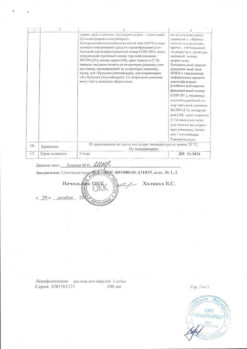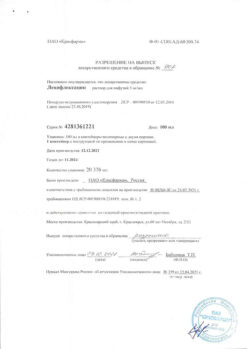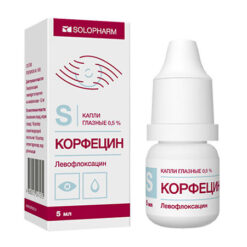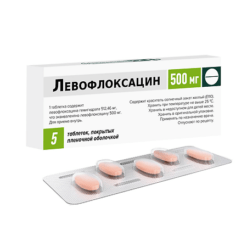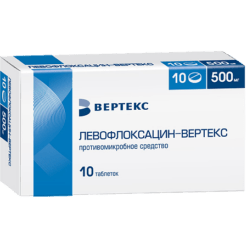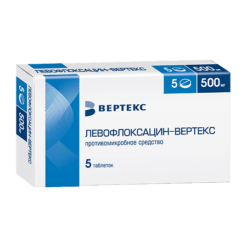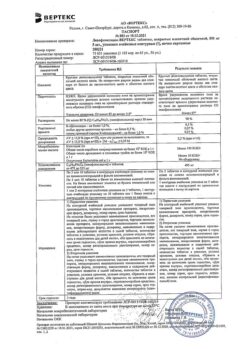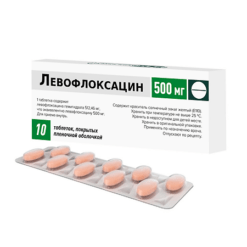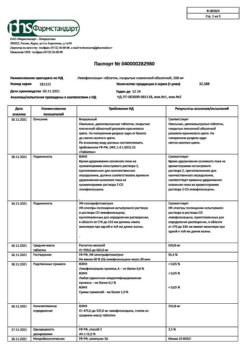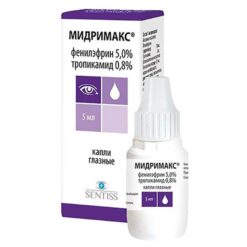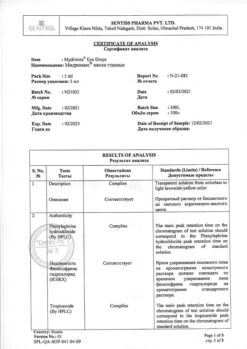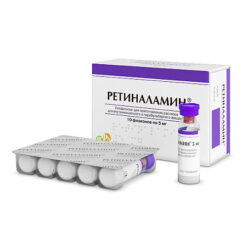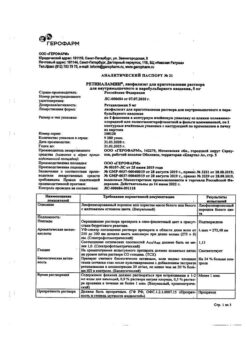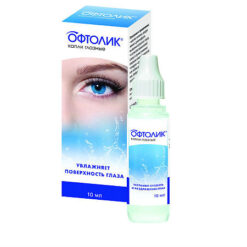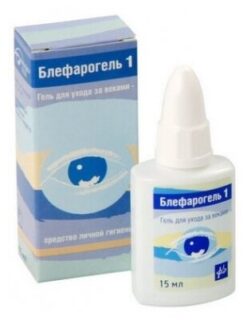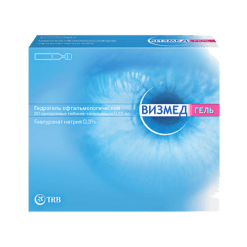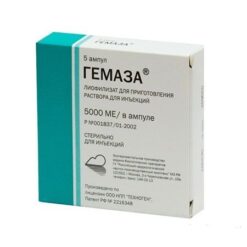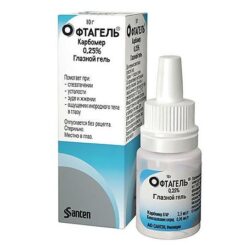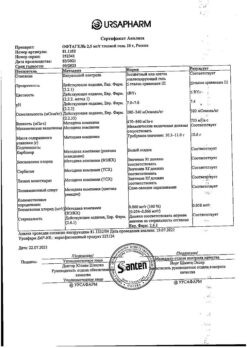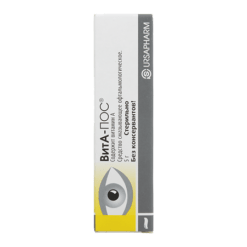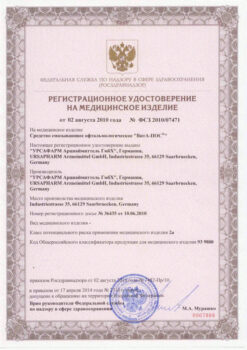No products in the cart.
Levofloxacin, eye drops 0.5% 5 ml
€5.22 €4.35
Description
A broad-spectrum antimicrobial agent, a fluoroquinolone.
Bactericidal action. It blocks DNA-enzyme (topoisomerase II) and topoisomerase IV, disrupts superspiralization and cross-linking of DNA breaks, inhibits DNA synthesis, causes deep morphological changes in cytoplasm, cell wall and membranes.
. Active against Enterococcus faecalis, Staphylococcus aureus, Staphylococcus epidermidis, Streptococcus pneumoniae, Streptococcus pyogenes and Streptococcus agalactiae, Viridans group streptococci, Enterobacter cloacae, Enterobacter aerogenes, Enterobacter agglomerans, Enterobacter sakazakii, Escherichia coli, Haemophilus influenzae, Haemophilus parainfluenzae, Klebsiella pneumoniae, Klebsiella oxytoca, Legionella pneumoniae, Moraxella catarrhalis, Proteus mirabilis, Pseudomonas aeruginosa, Pseudomonas fluorescens, Chlamydia pneumoniae, Mycoplasma pneumoniae, Acinetobacter anitratus, Acinetobacter baumannii, Acinetobacter calcoaceticus, Bordetella pertussis, Citrobacter diversus, Citrobacter freundii, Morganella morganii, Proteus vulgaris, Providencia rettgeri, Providcncia stuartii, Serratia marcescens, Clostridium perfringens.
Indications
Indications
Treatment of superficial bacterial eye infections caused by susceptible microorganisms in adults and children over 1 year of age.
Pharmacological effect
Pharmacological effect
Broad-spectrum antimicrobial agent, fluoroquinolone.
Acts bactericidal. Blocks DNA gyrase (topoisomerase II) and topoisomerase IV, disrupts supercoiling and cross-linking of DNA breaks, inhibits DNA synthesis, causes profound morphological changes in the cytoplasm, cell wall and membranes.
Active against Enterococcus faecalis, Staphylococcus aureus, Staphylococcus epidermidis, Streptococcus pneumoniae, Streptococcus pyogenes and Streptococcus agalactiae, Viridans group streptococci, Enterobacter cloacae, Enterobacter aerogenes, Enterobacter agglomerans, Enterobacter sakazakii, Escherichia coli, Haemophilus influenzae, Haemophilus parainfluenzae, Klebsiella pneumoniae, Klebsiella oxytoca, Legionella pneumoniae, Moraxella catarrhalis, Proteus mirabilis, Pseudomonas aeruginosa, Pseudomonas fluorescens, Chlamydia pneumoniae, Mycoplasma pneumoniae, Acinetobacter anitratus, Acinetobacter baumannii, Acinetobacter calcoaceticus, Bordetella pertussis, Citrobacter diversus, Citrobacter freundii, Morganella morganii, Proteus vulgaris, Providencia rettgeri, Providcncia stuartii, Serratia marcescens, Clostridium perfringens.
Special instructions
Special instructions
The drug should not be administered subconjunctivally or into the anterior chamber of the eye.
The drug should not be used while wearing hydrophilic (soft) contact lenses due to the presence of the preservative benzalkonium chloride, which can be absorbed by contact lenses and have an adverse effect on eye tissue, as well as cause discoloration of contact lenses.
To avoid contamination of the tip of the dropper and the solution, do not touch the eyelids or tissues around the eye when instilling. With long-term treatment with levofloxacin (as well as other antibiotics), excessive growth of insensitive microorganisms, including fungal flora, is possible.
If the course of the disease worsens or there is no improvement when using levofloxacin, it is necessary to discontinue therapy with levofloxacin and switch to therapy with antibacterial drugs of other groups, with an extensive ophthalmological examination, including biomicroscopy and fluorescein test.
There is no information on the effectiveness and safety of levofloxacin in the treatment of corneal ulcers. During clinical studies, no corneal precipitates were observed.
Effect on the ability to drive vehicles and machinery: the drug does not have a significant effect on the ability to drive vehicles or machinery. Immediately after instillation, temporary blurred vision is possible.
It is not recommended to drive vehicles or engage in other potentially hazardous activities that require increased concentration and speed of psychomotor reactions until clarity of visual perception is restored.
Active ingredient
Active ingredient
Levofloxacin
Composition
Composition
1 ml – levofloxacin 5 mg, which corresponds to the content of levofloxacin hemihydrate 5.12 mg
Pregnancy
Pregnancy
Levofloxacin is contraindicated for use during pregnancy and lactation (breastfeeding).
Contraindications
Contraindications
Hypersensitivity to levofloxacin or to any of the components of the drug, other quinolones. If you have one of the listed diseases, be sure to consult your doctor before taking the drug.
Side Effects
Side Effects
The incidence of adverse reactions during therapy with levofloxacin was about 10%. Most often, the severity of adverse reactions varied from mild to moderate severity; Undesirable reactions were noted mainly from the organ of vision.
Information about adverse events was obtained during clinical trials and post-registration use.
Immune system disorders: rarely (more than 1/10000, but less than 1/1000) – systemic allergic reactions, including skin rash; very rarely (less than 1/10000) – anaphylactic shock.
Nervous system disorders: uncommon (more than 1/1000, but less than 1/100) – headache.
Violations of the organ of vision: often (more than 1/100, but less than 1/10) – burning in the eye, decreased vision, filamentous mucous discharge in the conjunctival cavity; uncommon (more than 1/1000, but less than 1/100) – chemosis, conjunctival injection, papillary conjunctivitis, eyelid edema, eyelid erythema, eye discomfort, eye itching, eye pain, dry eye syndrome, photophobia.
Disorders of the respiratory system, chest and mediastinum: uncommon (more than 1/1000, but less than 1/100) – rhinitis; very rarely (less than 1/10000) – laryngeal edema.
The profile of adverse events when using the drug in the pediatric population is comparable to the adult population. If any of the side effects indicated in the instructions get worse, or you notice any other side effects not listed in the instructions, tell your doctor.
Interaction
Interaction
Levofloxacin increases T1/2 of cyclosporine.
The effect of levofloxacin is reduced by drugs that inhibit intestinal motility, sucralfate, magnesium- and aluminum-containing antacids and iron salts (a break of at least 2 hours is required between doses).
With simultaneous use of NSAIDs, theophylline increases convulsive readiness, corticosteroids increase the risk of tendon rupture.
Cimetidine and drugs that block tubular secretion slow down the elimination of levofloxacin.
Levofloxacin solution for intravenous administration is compatible with 0.9% sodium chloride solution, 5% dextrose solution, 2.5% Ringer’s solution with dextrose, combined solutions for parenteral nutrition (amino acids, carbohydrates, electrolytes).
Levofloxacin solution for intravenous administration should not be mixed with heparin and solutions that have an alkaline reaction.
Overdose
Overdose
The total amount of levofloxacin contained in one dropper tube or dropper bottle is too small to cause toxic reactions, even after accidental ingestion.
Storage conditions
Storage conditions
Store in a place protected from light, out of reach of children, at a temperature not exceeding 15°C for the drug in a dropper tube.
Store in a place protected from light, out of reach of children, at a temperature not exceeding 25°C for the drug in a dropper bottle.
Shelf life
Shelf life
2 years. The shelf life of the drug after opening is 14 days.
Manufacturer
Manufacturer
Moscow Endocrine Plant, Russia
Additional information
| Shelf life | 2 years. The shelf life of the drug after opening – 14 days. |
|---|---|
| Conditions of storage | Store in a place out of the reach of children in the dark place at a temperature not exceeding 15°C for the product in a dropper bottle. Store in a place out of the reach of children in the dark place at a temperature not exceeding 25°C for the product in the dropper bottle. . |
| Manufacturer | Moscow Endocrine Plant, Russia |
| Medication form | eye drops |
| Brand | Moscow Endocrine Plant |
Other forms…
Related products
Buy Levofloxacin, eye drops 0.5% 5 ml with delivery to USA, UK, Europe and over 120 other countries.


